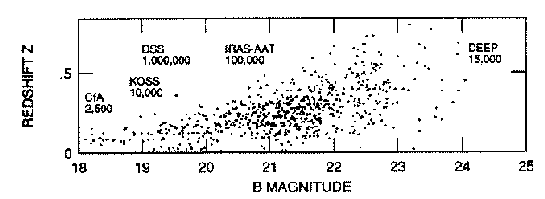 Galaxy Evolution
Galaxy Evolution
 Galaxy Evolution
Galaxy Evolution

Figure 1: Spectroscopic redshifts versus blue (B)
magnitudes of faint field galaxies from surveys by Koo-Kron, Hawaii,
Durham, and CFRS groups. Rough limits and numbers of galaxies for DEEP
are also marked.
The mystery of whether and how the blue galaxies have disappeared in recent times has gained further attention from findings that show the clustering of blue galaxies to be very small compared to normal galaxies, and from claims that counts of bright galaxies are twice those expected at low redshifts (Efstathiou et al 1991 ApJ 380, L47; Maddox et al 1990 MNRAS 247, 1P).After pioneering work of Butcher and Oemler, the claimed excess of blue galaxies in rich clusters of galaxies has also received enormous attention, including spectroscopic work that hints at bursts of star-formation (Butcher and Oemler 1978 ApJ 219, 18; Dressler and Gunn 1982 ApJ 263, 533). The source for this activity in clusters and the relationship of the blue cluster galaxies to the blue field population remain outstanding problems. Even the red galaxy population is not well understood; in particular, evidence for and against evolution in the stellar population and luminosity of red galaxies remains controversial. (Hamilton 1985 ApJ 297, 371). All of the above puzzles can be directly attacked through the spectra of faint galaxies. In the first years of DEEP, using the existing LRIS spectrograph on Keck, we plan to secure over 2000 spectra fainter than B=22 to address the evolution of the reddest and bluest galaxies in the field populations. A unique aspect of our approach is the use of high enough spectral resolution to distinguish galaxies of different masses based on their internal motions. The ability to study mass in addition to light means that DEEP can probe the evolution and clustering of dark matter on the scale of galaxies and cluster of galaxies. The addition of mass data may also provide the key that has so far been missing to distinguish true galaxy size from apparent brightness at large distances.
Home |
Overview |
Current Research |
Publications |
Archive
Personnel |
Funding & Sponsors |
Observational Resources